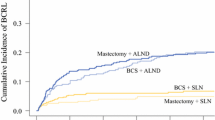Abstract
Background
The development of breast lymphedema (BLE) after breast/axillary surgery is poorly characterized. We prospectively evaluated clinical and surgical factors associated with development of BLE.
Methods
Patients undergoing unilateral breast-conserving surgery were prospectively enrolled preoperatively and followed for development of BLE. To augment the number of patients with BLE for evaluation of risk factors, postoperative patients identified in the clinic with signs and symptoms of BLE were also enrolled. Logistic regression with Firth’s penalized likelihood bias-reduction method was used for univariate and multivariate analysis.
Results
Of 144 women, 124 were enrolled preoperatively (38 of whom developed BLE), and 20 women with BLE were enrolled postoperatively. Any type of axillary surgery was the strongest factor associated with BLE (odds ratio, 134; 95 % confidence interval, 18 to >1,000). All 58 BLE events occurred in women with axillary surgery as compared with no events in the 46 patients without axillary surgery (p < 0.0001). Among 98 women who underwent axillary surgery, BLE did not occur more often after axillary lymph node dissection versus sentinel lymph node biopsy (p = 0.38) and was not associated with total number of nodes removed (p = 0.52). In multivariate analysis, factors associated with the development of BLE in the axillary surgery subgroup included baseline BMI (p = 0.004), incision location (p = 0.009), and prior surgical biopsy (p = 0.01).
Conclusions
Risk of BLE is primarily related to performance of any axillary surgery but not the extent of axillary surgery or number of lymph nodes removed. Other factors associated with BLE were increased body mass index, incision location, and prior surgical excisional biopsy.
Similar content being viewed by others
References
Petrek JA, Senie RT, Peters M, Rosen PP. Lymphedema in a cohort of breast carcinoma survivors 20 years after diagnosis. Cancer. 2001;92:1368–77.
Clarke D, Martinez A, Cox RS, Goffinet DR. Breast edema following staging axillary node dissection in patients with breast carcinoma treated by radical radiotherapy. Cancer. 1982;49:2295–2299.
Ronka RH, Pamilo MS, von Smitten KA, Leidenius MH. Breast lymphedema after breast conserving treatment. Acta Oncol. 2004;43:551–557.
Degnim AC, Miller J, Hoskin TL, et al. A prospective study of breast lymphedema: frequency, symptoms, and quality of life. Breast Cancer Res Treat. 2012;134:915–922.
Firth D. Bias reduction of maximum likelihood estimates. Biometrika. 1993;80:27–38.
Ploner M, Dunkler D, Southworth H, Heinze G. logistf: Firth’s bias reduced logistic regression. R package version 1.10. http://CRAN.R-project.org/package=logistf (2010).
Loprinzi CL, Okuno S, Pisansky TM, Sterioff S, Gaffey TA, Morton RF. Postsurgical changes of the breast that mimic inflammatory breast carcinoma. Mayo Clinic Proc. 1996;71:552–555.
Staren ED, Klepac S, Smith AP, et al. The dilemma of delayed cellulitis after breast conservation therapy. Arch Surg. 1996;131:651–654.
Baddour LM. Breast cellulitis complicating breast conservation therapy. J Intern Med. 1999;245:5–9.
Silverstein MJ, Recht A, Lagios MD, et al. Special report: consensus conference III—image-detected breast cancer. State-of-the-art diagnosis and treatment. J Am Coll Surg. 2009;209:504–520.
White RR, Halperin TJ, Olson JA Jr, Soo MS, Bentley RC, Seigler HF. Impact of core-needle breast biopsy on the surgical management of mammographic abnormalities. Ann Surg. 2001;233:769–777.
The American Society of Breast Surgeons. Percutaneous needle biopsy for image detected breast abnormalities. https://www.breastsurgeons.org/statements/PDF_Statements/Percutaneous_Needle_Biopsy.pdf. Accessed June 14, 2013.
McLaughlin SA, Wright MJ, Morris KT, et al. Prevalence of lymphedema in women with breast cancer 5 years after sentinel lymph node biopsy or axillary dissection: objective measurements. J Clin Oncol. 2008;26:5213–5219.
Sener SF, Winchester DJ, Martz CH, et al. Lymphedema after sentinel lymphadenectomy for breast carcinoma. Cancer. 2001;92:748–752.
Zippel D, Siegelmann-Danieli N, Ayalon S, Kaufman B, Pfeffer R, Zvi Papa M. Delayed breast cellulitis following breast conserving operation. Eur J Surg Oncol. 2003;29:327–330.
Goffman TE, Laronga C, Wilson L, Elkins D. Lymphedema of the arm and breast in irradiated breast cancer patients: risks in an era of dramatically changing axillary surgery. Breast J. 2004;10:405–411.
Senofsky GM, Moffat FL Jr, Davis K, et al. Total axillary lymphadenectomy in the management of breast cancer. Arch Surg. 1991;126:1336–41, discussion 1341–1342.
Acknowledgments
This publication was made possible by the Mayo Clinic CTSA through Grant UL1RR024150 from the National Center for Research Resources (NCRR), a component of the National Institutes of Health (NIH). Amy C. Degnim was also supported for this project by the CA90628-08 Paul Calabresi Award for Clinical-Translational Research (K12) via the Mayo Clinic Cancer Center. We also thank the women who volunteered in this study.
Conflict of interest
The authors declare that they have no conflict of interest.
Author information
Authors and Affiliations
Corresponding author
Rights and permissions
About this article
Cite this article
Boughey, J.C., Hoskin, T.L., Cheville, A.L. et al. Risk Factors Associated with Breast Lymphedema. Ann Surg Oncol 21, 1202–1208 (2014). https://doi.org/10.1245/s10434-013-3408-5
Received:
Published:
Issue Date:
DOI: https://doi.org/10.1245/s10434-013-3408-5




